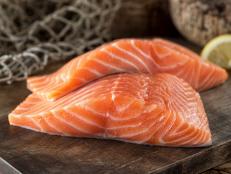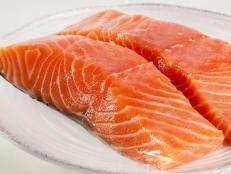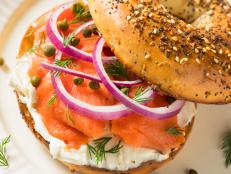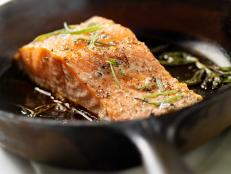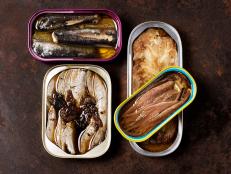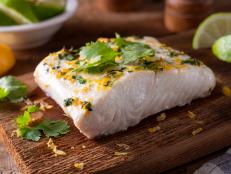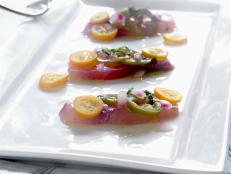How to Season Salmon
Salt, pepper and beyond: Everything you need to know for perfectly flavorful salmon.

Olha_Afanasieva/Getty Images
By Alice K. Thompson for Food Network Kitchen
Alice is a contributing writer and editor at Food Network.
Salmon is one of the most popular fish with beginner and expert cooks alike, and not just because its meaty texture makes it easy to grill, bake or pan-sear. It’s also got a natural richness that’s perfect for everything from the simplest seasoning (just salt, maybe pepper!) to complex spicing. Here’s everything you need to know to make your next salmon meal perfectly flavorful.
How to Season Salmon
Start with salt and pepper. Salmon’s rich flavor and lovely color means that you can go as simply as you like for superb taste and beautiful presentation. So if you’ve got the inclination to use just salt and pepper, go for it!
Step 1: Pat Dry
Dry all sides of the salmon. As you’re doing so you can run your fingers along the flesh of a fillet to identify and pull out any pin bones. Place the salmon on a plate or cutting board.
Step 2: Prep with Oil
Although not absolutely necessary, a brush of oil or another sticky substance (think mayonnaise or mustard) can help seasoning adhere to the fish. Plus it may keep the salmon from sticking during grilling or pan-searing. If you choose to, brush or rub the oil onto all sides, including the skin if you have a salmon steak or skin-on fillet.
Step 3: Sprinkle with Salt and Pepper
Sprinkle the salmon with salt, preferably kosher salt or a semi-coarse sea salt. Hold your hand about 10 inches above the fish to get an even coating. Grind a little fresh pepper over the fish. Flip the fish and repeat on the other side. That’s it! You’re ready to cook.
How Much Salt Should You Use on Salmon?
In general, 3/4 to 1 teaspoon kosher salt per pound of salmon is a good rule if you’re not adding additional salty ingredients. About half that much pepper is good if you’re not adding other peppery ingredients.
Basting or glazing the fish with something like teriyaki or barbecue sauce, or serving it with a salty sauce? Season more lightly.
What If You Have Health Concerns About Salt?
If you’re watching your sodium intake, or just have a greater sensitivity to salt, by all means lower the amount you use. Remember that a generous squeeze of lemon after cooking and a shower of fresh herbs (parsley, cilantro or chives are excellent) is a tried-and-true way to add flavor to food when decreasing salt. A drizzle of honey or low-sodium soy sauce is also excellent.
How to Season Salmon for Baking
Seasoning salmon with salt and pepper for baking is exactly like seasoning it for any other cooking process: Pat it dry, sprinkle all sides with salt and pepper (including skin if your fish has it) and use a lighter touch if you’re adding salty or peppery ingredients later. Since the fish sticking during baking isn’t typically a concern, you can skip brushing the fish first with oil if you prefer; just pat the seasoning gently into the flesh. The indirect heat of baking means you have almost unlimited choices for further flavor: Spice blends, sturdy fresh herbs, barbecue sauce and more.
How to Season Salmon for Grilling
If you’re grilling salmon, season it with salt and pepper like you would for any other cooking technique: Gently pat the fish dry, brush it with oil to help prevent sticking and sprinkle salt and pepper on all sides (including the skin). Take into account any other salty or peppery ingredients you might add later when you determine how much to sprinkle on.
Using a marinade for grilled salmon is an excellent way to combine all your flavors (salt and pepper included) in one go, but remember that you want to marinate fish for no more than 30 minutes so any acid doesn’t begin cooking the flesh. And be judicious with sweet ingredients like honey or maple syrup: They can easily burn during grilling, so you may want to brush them on as a glaze towards the end of cooking.
Best Flavors and Spices for Salmon

Arx0nt/Getty Images
Citrus: Juice or zest, citrus is one of the best matches for salmon we know. Not only is it brilliant at cutting salmon’s richness, but also it is your go-to ingredient for cutting salmon’s “fishiness.” Just remember that the acid in citrus juice will begin to cook the flesh, so add it as close to cooking as possible. Zest you can add anytime.
Fresh herbs: Cilantro, basil, chives, rosemary, parsley, tarragon and more: It’s hard to think of an herb that doesn’t love salmon. Plus their bright color is a great contrast to salmon’s rosy hue. You can even make an herb sauce to serve it with; salmon is rich enough to stand up even to the strong flavor of a classic Chimichurri Sauce.
Colorful peppercorns: Feel free to mix it up with something other than your standard black pepper. The floral scent and brilliant color of pink peppercorns are a favorite with salmon. Green peppercorns (dried and cracked, or brined from a jar for sauces) are a mild match for salmon. And tongue-tingling Sichuan peppercorns are fun and unexpected.

Matt Armendariz
Teriyaki: Sweet, briny teriyaki is a classic marinade or baste for meaty fish, and for salmon steaks in particular. Store-bought is one of the most delicious salmon shortcuts of all time, but you can make your own Teriyaki Sauce (pictured above) in 5 minutes.
Blackening rub: Spicy blackening rub is excellent if you want a robustly flavored salmon. You can buy any number of blends, or make this Blackening Spice from pantry staples you probably have on hand.
Cajun seasoning: A Cajun seasoning blend is similar to blackening spice and also excellent with salmon when you want to go big flavor-wise. You can make up a big batch of this Cajun Spice Mix in minutes.
Taco seasoning: Salmon tacos? Yes! Salmon’s bold flavor is excellent with avocado, salsa, crema and more. A dusting of taco seasoning is all it needs before a quick sear. You can skip the packet with this five-ingredient Taco Seasoning.

Armando Rafael
Honey mustard: A big dollop of honey mustard before baking is all it takes for arguably the easiest, most delicious baked salmon ever. You really don’t need a recipe, but if you want one this Healthy Honey-Mustard Roasted Salmon (pictured above) is quick and versatile.
Maple syrup: Maple’s deep caramel notes and moderate sweetness is a match made in heaven for salmon. You can use a drizzle alone or mix it with miso or mustard. Whisk it with soy and ginger for a streamlined teriyaki sauce.
Mayonnaise: Mayo has become the trendy go-to for crusting any number of dishes, and it’s excellent on salmon. You can use it straight-up for brushing on the fish in place of oil, or stir it up with herbs (it keeps fresh ones moist), just about any spice, sriracha, garlic… you name it!
Related Links:
























